‘Worthy successor of Tone and Casement’? Seán Russell and the IRA, (Part Two, 1931-40)
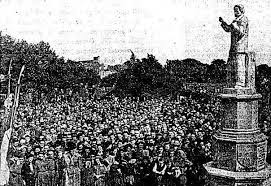
By Gerard Shannon.
This is the second in a two-part article, the first can be found here.
On Sunday, 9th September 1951, an impressive crowd gathered at Fairview Park for the unveiling of a new statue following a parade from Dublin city centre. The statue was of the late Chief-of-Staff of the Irish Republican Army (IRA), Seán Russell, who died at sea over a decade before. Russell was depicted on a large plinth, suited and with his right fist clenched in defiance.
The republican news sheet, The United Irishman, noted the parade that marched from Parnell Square represented groups across the breath of militant Irish republicanism, and included units of the IRA, cumann of Sinn Féin, along with members of Fianna Éireann, Cumann na mBan, Cumann na gCailiní, and Clann na Gael. There were also representatives from Dublin City Council and the GAA.
In 1951, when a statue was unveiled to his memory in Dublin Sean Russell was referred to as ‘a worthy successor of [Wolfe] Tone and [Roger] Casement’.
The main speaker was Mr. T. A. McMonagle of Clann na Gael, the Irish-American republican support organisation, who had funded the monument.[1] McMonagle, in his oration, demonstrated the respect Russell’s old allies in the United States still held for the late comrade, referring to Russell as ‘one of Ireland’s greatest soldiers… and one of the… most unselfish characters I have ever known.’
In the same issue of The United Irishman a detailed account of Russell’s final days ended with the statement, ‘Seán Russell… worthy successor of Tone and Casement.’[2] The reference itself was a none-too-subtle allusion between Russell seeking aid from the government Nazi Germany, to earlier efforts led by Irish republicans to secure international help for the cause.
It is striking that Russell received such praise only over a decade after his death, and in such a tribute as in the form of a prominent statue, particularly when more well-known earlier figures from the pantheon of Irish republicanism still lacked such a monument at the time. Yet, such contemporary tributes do much to obscure the convoluted circumstances of Russell’s passing; not to mention how much he was a divisive figure within the IRA in the final decade of his life.
The IRA Divided
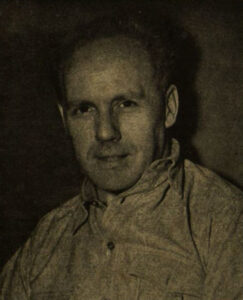
In August 1931, Russell, on behalf of the Army Council, visited the United States on a fund raiding tour for the IRA. However, he generally found Clan na Gael, the support organisation for Irish republicanism in the States, had greatly dwindled in terms of fund raising and membership.[3]
However, Russell built important contacts among the more militant adherents within the Irish-American diaspora there, which would prove important some years later.
Along with his continuing work as quartermaster which partly involved regular visits to various IRA units, Russell cultivated an important support base within the IRA that was to help him greatly in the years ahead.
In the interim, the political fortunes of the IRA in the Irish Free State were to change dramatically. Much of this period involved major debate within the IRA, and the encouragement of a more leftist drift and embrace of class politics by leading figures such as Peader O’Donnell, Seán MacBride and Frank Ryan.
The IRA struggled to define its political position in the 1930s but Russell kept aloof from ‘political debates’.
George Gilmore, a noted left wing republican, recalled Russell’s own reticence with such debates. He was, Gilmore recalled, ‘not interested in “political” questions. His sole interest was in armaments… he would impatiently refuse to “talk politics” ’.[4]
These debates within the IRA took place against the backdrop of Fianna Fáil, led by Éamon de Valera, at last winning a majority in the 1932 election in the Irish Free State; and a further election win in 1933 cemented de Valera’s popularity with the republican constituency.
De Valera was keen for the IRA to leave the stage and recognise his government’s mandate for a new republican form of constitutionalism that would peacefully dismantle aspects of the Anglo-Irish Treaty. The leadership of IRA, despite seeing the ban on the organisation being lifted by the incoming government, was to find the new political dispensation increasingly challenging, facing both dwindling resources and reduced membership.
While Seán Russell admitted to his peers that he had ‘no liking for political parties’, he did at least see the advantage in the late 1920s of Fianna Fáil becoming the government of the Irish state and the potential advantage this could bring to republicans.[5] At the time of the 1932 election, Seán Russell, along with Tom Barry, felt De Valera’s government would re-declare the Republic and continue the ‘national advance.’[6]
Russell also played a central role in IRA intervention during the 1933 Northern railway strike, in which the IRA fired some shots at strike breakers and ended up shooting dead an RUC officer, and seemed enthusiastic about the prospect of involving Protestant strikers.[7] This did not translate into him becoming an advocate of trade union politics, however, despite IRA flirtations with strike activity early in the decade.
On occasion, he took on the role of a public speaker for the republican cause, such as on behalf of an abstentionist republican candidate running for Stormont in 1933, in which Russell told a crowd in Portadown, that the ‘day (was) fast approaching when the sectarian catch cries, which were dividing the people of the north, would disappear.’[8]
An insight into his political thinking, and his belief in the primacy of military action, is reflected in an oration by Russell at an Easter commemoration taking place at Drumboe Castle in April 1933, the site of the execution of four anti-Treaty IRA volunteers during the Civil War.
Referring to the current political set-up in the Free State, Russell referred to how ‘all our national weaknesses are due to short-sightedness, to our proneness to stray away into bye-paths, where our true national vision becomes obscured… ’ Russell how noted ‘our moral right to arm: to equip to defend our nation by arms, is questioned.’ He pointed out to those gathered ‘you have a national obligation, and a moral right to fight for your national rights – your country’s freedom.’
Russell dismissed Fianna Fáil’s efforts thus far in government, referring to their entry into the Leinster House parliament in 1927 as ‘a desertion of the Republic.’ Referring to Fianna Fáil’s gradual dismantling of the various terms of the Anglo-Irish Treaty, Russell argued that ‘instead of scrapping the Treaty they [Fianna Fáil] offer you a popularised Treaty.’ The IRA quartermaster displayed little ambiguity when imploring republicans to ‘never again allow it to happen that moral right give way to political convenience.’[9]
Russell would later write of a two-hour meeting he had in Government Buildings with de Valera in 1934, in the latter’s capacity as President of the Executive Council; the latter having requested Russell’s presence as a member of the IRA leadership.
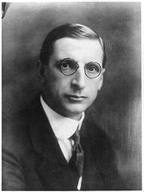
Russell claimed de Valera pushed for unity between the IRA and Fianna Fáil, provided the IRA surrendered its arms to the government and cease all military drilling. When Russell dismissed the ideas as impracticable, he suggested co-operation from the IRA provided de Valera put ‘the issue of the Republic before the people at the next General Election and support it, or declare the Republic within a reasonable time.’
When Russell pushed for this period to be five years, he added: ‘… in the meantime you need have no embarrassments so far as we [the IRA] are concerned, as we will co-operate with you in every way.’ De Valera, in Russell’s account, quickly dismissed the idea and brought the meeting to a close.[10]
The departure of many left-wing IRA activists throughout the 1930s, particularly on the founding of the ill-fated Republican Congress in 1934, removed considerable political talent from within the organisation, and ultimately also allowed for the more military strain– such as that espoused by Russell – to dominate. Seán Cronin, later a successor as IRA Chief-of-Staff, concluded that Russell of ‘all the IRA leaders of the 1920s and 30s… [was] probably the most conservative, politically and socially.’[11]
Joseph McGarrity

Russell would emerge, in the later 1930s, as the chief, fervent proponent of a new bombing campaign on this English mainland, similar to earlier republican efforts in the 1880s and 1920. As a result of his frequent contact with IRA units as IRA quartermaster, Russell gained a loyal cadre of followers to whom the idea of renewed military action against England greatly appealed. Another key relationship for Russell was his association with Joseph McGarrity, the Philadelphia-based leader of Clan na Gael.
Unhappy at the constitutional drift of Fianna Fáil, McGarrity (formerly a key ally of de Valera during his trip to the United States in 1919-20), had grown distant from ‘the Chief’ and little appreciated or understood Fianna Fáil’s political success. McGarrity was also considerably disenchanted with the inner convulsions within the IRA over its political direction and its lack of a solid plan for a new military campaign.
Along with Joe McGarrity of Clan na Gael, Sean Russell pushed for a new IRA bombing campaign in Britain in the late 1930s.
In Seán Russell, McGarrity found a willing and seemingly capable ally. Moss Twomey felt Russell and McGarrity ‘were alike in their single mindedness and in their ability to overcome opposition by ignoring its existence’.[12] Russell visited the United States in July of 1936, and met McGarrity. Both men reached a ‘complete understanding’ on this new campaign, with McGarrity promising finance and vital resources.[13] On his return to Ireland, Russell wrote to McGarrity, that in the IRA, the ‘idea [of a bombing campaign] has been accepted favourably all round… We are hoping to make a start before long…’[14]
In May 1936, the IRA Chief-of-Staff, Moss Twomey, had been arrested by the Irish security forces following a spate of IRA activities, including killing of alleged Garda informers and of a retired British admiral, Henry Sommerville, which culminated in an impatient Fianna Fáil government again declaring the IRA an illegal organisation.
Seán MacBride was co-opted as Chief-of-Staff, and the following months clashed with Russell who fervently advocated for the bombing campaign in England. Tom Barry, also on the Army Council, was dismissive of Russell’s idea and wanted to push for the court-martial of the latter over an apparent misappropriation of IRA funds and arms.[15]
Dan Gleeson was one of the IRA leaders involved in the court-martial of Russell, which took place in January 1937. Gleeson felt it was a ‘fiasco’, particularly as Russell chose to have no-one speak in his defence. Gleeson felt that none of those involved were happy in their roles, though it was regarded as a positive when Russell was finally expelled.[16]
The consensus of the court martial appeared to be that Russell had not kept any of the funds for himself, but had instead spent it on IRA activities without the approval of the Army Council.[17] For the time being, Russell was marginalised.
Even this seeming setback was not to prove any kind of deterrent for Russell’s ambitions, or his most prominent ally, McGarrity. Russell was invited to return for a public speaking tour across the United States throughout the summer of 1937, despite his previous dismissal from the IRA. Though Russell was to find Clan membership and financial support poor in certain areas, he felt that his promise of a new military campaign had, in his own words, had created a ‘new interest’ in Irish affairs, and that ‘much can be achieved if a good strong national stand is made by our people at home.’[18]
Russell in short, remained determined that the proposed campaign in England would take place – with or without support of the IRA Army Council. Writing to McGarrity in November 1937, Russell made clear that he and his allies ‘have already sufficient men who are capable of putting our policy into effect, and we fully realise that force of the example and the increasing support which will inevitable come to us with our initial successes…’ Russell, it seems, was hoping that the proposed IRA Convention in April 1938 would see the plan for the bombing campaign in England being adopted as IRA policy.[19]
Russell was for a time dismissed from the IRA by opponents of the bombing campaign, but got himself elected chief of Staff in 1938.
At the Convention, the current Chief-of-Staff, Tom Barry, led the opposition to the England bombing campaign, declaring to those gathered it was as ‘doomed to failure as the [Fenian] dynamiters of the 1880s’. Barry’s preference for a number of years had been for the IRA to push for a campaign against British military targets within the Northern Ireland state.
However, Russell’s supporters won the day in a majority vote, with Russell installed as Chief-of-Staff. Barry and four others resigned from the IRA Executive, arguing the IRA Army Council had behaved ‘unconstitutionally’ in appointing a ‘dismissed Volunteer’ as Chief-of Staff. It was the end of Barry’s sometimes turbulent career in the IRA. He expressed no confidence in the new leadership and felt the proposed new campaign was ‘unethical and immoral’.[20]
However dubious the methods used in gaining this position as IRA Chief of Staff, Seán Russell had now at last ascended to the top of the organisation to which he had devoted much of his adult life. However, the greatly diminished fortunes of the organisation by now boded ill for its future success.
A Controversial Chief-of-Staff
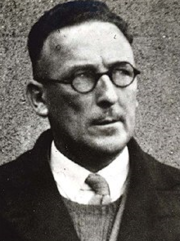
Russell and his allies wasted no time in making contact with IRA activists in both Ireland and England, beginning major efforts at training in the use of explosive devices. One important recruit to Russell’s ranks was the return of Seamus O’Donovan, the former IRA Director of Chemicals, who devised the overall strategy for the sabotage campaign, known as the S-Plan.[21]
O’Donovan’s strategies involving the bombing of key commercial and infrastructural targets across England. O’Donovan had been absent from IRA activities since the Civil War and been personally convinced by Russell to return to the ranks.
Not all of those within the IRA shared Russell’s heightened confidence that the campaign could succeed. Moss Twomey, who had been recently released from prison, stayed on as adjutant-general on Russell’s staff. Along with Seán MacNella, Twomey toured IRA units in England ahead of the campaign start but was disheartened at what he found in terms of preparedness and resources – and ultimately left the IRA as a result.
Russell convinced those members of the Second Dail (1921-22) who had always refused to recognise the legitimacy of subsequent Dails, to vest the authority of the Irish Republic in the IRA Army Council.
Russell also devised, with his allies, a new political formula for the IRA. Since 1922, a certain contingent of anti-Treaty republican TDs who were members of the Second Dáil Éireann (elected in 1921) continued to meet as the purported ‘republican government’. This was in light of their view that the Second Dáil had never been dissolved prior to the Civil War, and refusal to recognise the democratic institutions of the Free State. The IRA had withdrawn its support for this body by 1925 and by 1938, the number of these surviving fundamentalist republican deputies had dwindled to seven, solely supported by a moribund Sinn Féin party.
Russell now devised an intriguing strategy involving this grouping, related to a little-recalled decision reached by Dáil Éireann on 11th March 1921 (during the War of Independence when the Dáil was banned as an ‘illegal assembly’), which had decreed that when circumstances, such as war, reduced the make-up of the Dáil to five deputies, government duties should be handed to the leadership of the Volunteers [the IRA].[22]
Russell met this grouping of ex-TDs, led by Mary MacSwiney, sister of hunger striker Terrence MacSwiney, at her home on 8th December, 1938 – the anniversary of the execution of IRA leaders in Mountjoy in 1922. After a brief discussion, the group agreed to handover their ‘executive authority’ to the IRA Army Council, and passed a resolution: ‘We hereby delegate the authority reposed in us to the Army Council in the spirit of the decision taken by the Dáil in the spring of 1921…’[23]
One republican deputy, Tom Maguire, initially refused, perhaps disgruntled at his non-involvement in the meeting. However, he was won over by Russell’s written response: ‘is this not the recognition of the Republic that we all seek.’ Maguire then agreed with the rest of the republican deputies.[24] In keeping with this fundamentalist republican belief, the IRA Army Council in their view could now claim to be the de jure government of the Irish Republic as declared in 1916 – for Russell and his allies, an important tool for their propaganda.
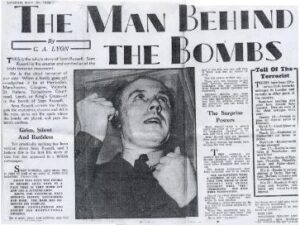
Shortly thereafter, Russell called a general meeting of the IRA Convention in Dublin. There, the 50 delegates reaffirmed their support for him.
On 12th January 1939, a statement was issued to British Foreign Secretary, Lord Halifax, ‘signed on behalf of The Republican Government and the Army’, giving notice for the British government to withdraw all military forces from Ireland.
If not, the IRA would be ‘compelled to intervene actively in the military or commercial life of your country as your government are interfering in ours.’[25] On Monday, 16 January 1939, the bombings began, with seven major explosions on power stations and electrical lines across England.
The bombing campaign in England soon ran aground but in 1939-40 killed 7 civilians and injured 96
Despite the initial, moderate success, the campaign soon ran aground. Intelligence failures, most disastrously the authorities coming into possession of a copy of O’Donovan’s S-Plan, mass arrests, and inevitable civilian casualties diminished whatever momentum the campaign could have had. One particularly tragic instance involved a bomb in Coventry on August 25, which killed five civilians and injured 70, for which the alleged bombers, Peter Barnes and James McCormack (who admitted to making but not planting the bomb) were later hanged.
One chief reason for the campaign’s failure was the unfamiliarity of many IRA volunteers within the country in which they were operating. An IRA veteran Dan Keating recalled, ‘There were too many people sent over who had no knowledge whatsoever of the country or where they were going…’[26]
Writing to McGarrity in March 1939, Russell talked of the opening of the campaign, with some slight acknowledgement its effects were perhaps not to his liking: ‘Our successes, through perhaps small, have gone to their (the Volunteers) heads. They realise they have a big job, and maybe a long one, and they are preparing steadily for it.’ In the same letter, Russell made an intriguing reference to a representative of the German government meeting the IRA leadership.[27]
A meeting had taken place in February 1939 between Russell and other IRA leaders with a German agent, Oskar Pfaus, who had secretly arrived in Ireland. This exchange left Russell elated at the prospect of munitions and arms being supplied by Hitler’s government in Berlin, (which ultimately never materialised for the English campaign).[28] Russell, meanwhile, had departed for the United States for another fund raising tour in April 1939.
This had come at a difficult time for Russell’s leadership, as elements within the IRA leadership in England had already grown wary at the possibility of success in the campaign. Seán Fuller, who was involved in operations in Birmingham, even made a direct appeal to Russell to halt the campaign following a spate of arrests of republican activists.[29]
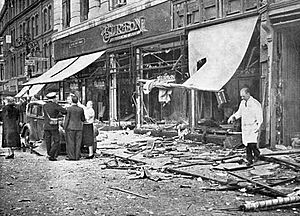
The campaign’s main architect refused to be deterred. From the US, he revealed a burgeoning confidence when he wrote to his temporary replacement as Chief-of-Staff, Stephen Hayes, (whom he had appointed without any formal ratification by the Army Council). Russell wrote:
‘Every day I feel more and more assured of success. Every day I find those who for years saw no future for the IRA and no hope of national revival coming back to the Clan to offer help… Nobody now can say the Irish question is settled for all time.’
The letter closed with a promise from Russell to Hayes to return home to Ireland soon.[30] However, seemingly promising new developments were to delay Russell’s homecoming for the immediate future.
Over the course of the sabotage campaign in England, from January 1939 to March 1940, about a hundred republican men and women had been sentenced to various terms of penal servitude, and the aforementioned two IRA volunteers executed. The final total for the campaign was 300 explosions, 10 deaths (including 7 civilians), and 96 injuries across England.[31] By any measure, this overly-ambitious campaign had failed. The idea it could gain enough momentum to bring the British to the negotiating table to evacuate Northern Ireland, was deemed quite rightly in the view of a recent study, to be ‘ludicrous’.[32]
Final Days
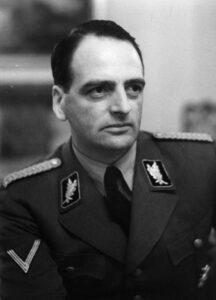
Taking advantage of previous IRA contacts with the German government, Russell travelled from the United States to Berlin, with the aid of American supporters, in May 1940. His departure could not have come at a more opportune time.
The US authorities had been seeking to deport Russell over his soon-to-expire visa, hoping to avoid a potential embarrassing diplomatic incident involving the British monarch King George VI, who was on an official visit to the United States.
In Berlin, Russell was accredited full diplomatic privileges by the authorities, being supplied with a villa, complete with extensive grounds in the Grunewald suburb, a library, war maps, and a radio.[33]
This perhaps reflected the importance of his presence in the eyes of the German authorities. Russell maintained closest contact with Edmund Vessenmayer, the German Foreign Office’s ‘Special Adviser’ on Ireland.[34] Vessenmayer was later to be a key architect of the Nazi government’s Holocaust policies in both Hungary and Croatia.
Russell died, it is thought of a burst ulcer, aboard a German u-boat on his way back to Ireland in August 1940.
In late May, Russell was trained in the use of sabotage material and held conferences with German military leaders on possible actions on the English mainland. What remains clear is that no definite plans were agreed to, save for the possible transport of Russell back to Ireland. Russell also met Joachim von Ribbentrop, the German Foreign Minister, who seemed impressed by the IRA Chief-of-Staff. Russell was sure to keep the German authorities at arm’s length, wanting no strings attached for anything supplied to the IRA, but made a specific request: the release of his old IRA comrade, Frank Ryan from a Spanish prison.[35]
Ryan had been held in Burgos Prison having been captured as part the Irish contingent who fought with Spanish republicans against the forces of General Franco in the recent Spanish Civil War. Both he and Russell had gone on considerably different political trajectories since the convulsions within the IRA in the early 1930s; beginning with Ryan’s departure from the IRA to join the ill-fated Republican Congress.
Ryan was brought to Berlin in early August where Vessenmayer watched the reunion of the two former comrades with interest. Seán Russell threw his arm around Frank Ryan, and said, ‘I’m going to Ireland tomorrow, Frank. Will you come with me?’[36] Ryan readily agreed. While this may seem surprising in light their differences, Ryan later explained in a letter to the Irish Minister in Madrid, Leopold Kearney: ‘He [Russell] and I were always good personal friends… ’[37]
The mission to send both men back on their fateful journey to Ireland aboard a German U-Boat was named ‘Operation Dove’. A surviving Abwehr ‘War Diary’ stated that ‘Russell was given no definite assignment of any sort… All the [German] Foreign Office gives him is the chance to make use of Ireland’s opportunity.’
Apparently all Russell had in terms of luggage was a special wireless set to communicate with Berlin, and a code. Though Ryan was a fellow passenger, it would become soon apparent he was not privy to Russell’s exact plans. Their destination was to land at Smerwick Bay on the Dingle peninsula by August 15th, and from there make their way to Dublin.
Though the U-Boat successfully made it through the British blockade, the cramped quarters, and lack of fresh air and exercise, proved arduous for both men. Fatefully so, for Russell. From the outset of the journey, Russell suffered severe vomiting and stomach pains. Despite the efforts of a medical orderly and Ryan, Russell’s cramps increased in severity and he died on August 14th – with the U Boat hundred miles west of Galway. He died in Ryan’s arms.
On his return to Berlin, Ryan gave two sworn affidavits to the German authorities, where subsequently two leading physicians deduced that Russell probably died of a perforated duodenal ulcer.[38] Ryan himself rubbished speculation on Russell’s death, writing to the Irish Minister in Madrid, Leopold Kearney, the following year: ‘These rumours of his having met a violent death in Gibraltar, and in Barcelona are absurd. To my knowledge he never set foot in either place. The other rumour about my part in an alleged assassination doesn’t worry me.’ Ryan also hoped to return Russell’s personal effects, including his watch, to his relatives in person. ‘And – God speed the day!’ he ended the letter.[39]
Frank Ryan unfortunately never got the chance, he died in a hospital in Dresden in the summer of 1944, due to pleurisy and pneumonia. His body was later repatriated to Ireland in 1979. Dr. Veesenmayer, who had come to hold Seán Russell in high regard, opted to preserve these personal effects and papers for his relatives. Russell also apparently sat for a portrait during his time in Germany, however, all of this was lost in later Allies air raids on Germany.[40]
By the end of the war, mass internment of IRA members and the executions of six by the government of Éamon de Valera, as a result of the organisation’s hostile actions against the Irish State’s security forces, all but destroyed the organisation. Internment was introduced not after English bombings but after the ‘Christmas raid’ in December 1940, in which the IRA raided the Irish Army’s ammunition dump in Dublin’s Phoenix Park. The six men executed were convicted of the shooting of Gardaí, or in one case of an informer.[41] Another two IRA prisoners died on hunger strike in 1940 and another in 1946.
Together with the backdrop of the failed sabotage campaign in England the war years greatly diminished the fortunes of a profoundly demoralised IRA. The organisation’s connection with the Nazi government through this period remains a murky, sometimes confused one; at the time of Russell’s stay in Berlin and thereafter, there were curious episodes within Ireland involving German spies and their associations with republicans.
Consistently, German officials seemed to assume the IRA, despite their small membership and limited resources, had a more important role in Ireland itself particularly in terms of their influence on de Valera’s neutral government.[42]
The reticence of German intelligence towards the IRA is reflected in the recollections of one Nazi agent, Hermann Goertz, following the war:
‘In spite of the fine qualities of individual IRA men, as a body I considered them worthless. A leader once boasted to me that he had in a certain district – I was not really interested – 5000 sworn members. I answered him that I personally would be completely satisfied with 500 men who knew how to obey an order. I would march them to Belfast and destroy the Harland and Wolff shipyards, and these men would have done more for Ireland then 5000 talking about the Second Dáil and Third Dáil and their legality.’[43]
Ultimately, it will remain a subject of conjecture what the long term result of further contacts between Russell and the German authorities would have been, particularly had the tide of the war turned in Germany’s favour.
Irish Republican hero or Nazi collaborator?
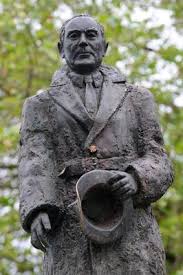
The original statue in Fairview Park, and later versions of it, do much to contribute to the on-going discussion of Seán Russell’s legacy, enduring even into the recent debates and controversies worldwide over public statues and memorials.
This statue’s history has been much documented, including the changes, intentional damage and replacements, with the most recent version of the statue being put in place by the republican commemorative body, the National Graves Association, in 2009.[44]
Is Russell deserving of such a tribute, even within the ranks of Irish republicanism? For much of his revolutionary career, through to the Rising and Civil War, he was recognised as a charismatic leader, both physically brave and highly capable in his various leadership roles.
That huge compliments came from figures who diverged later from him politically, such as Oscar Traynor and Liam Daly is striking. His contemporaries through the 1920s and 30s, even those opposed to him, widely recognised his personal sincerity and his firm, if unsophisticated, republican beliefs.
Russell was popular among Irish Republicans for giving the IRA a new military direction, but is condemned in many quarters for his bombing campaign in England and cooperation with Nazi Germany.
How did Russell regard his own personal ideology, particularly with the drift of elements within the IRA towards a more radical, leftwing direction in the 1930s?
While he left little written political testimony, his contemporary communications and the accounts of his political activities give the impression of a determined militant – firmly set on the primacy of strictly military affairs in the IRA, with a great desire for swift, decisive military action.
There is some evidence that Russell recognised the potential of the IRA engaging in political activity, provided it shared the ultimate aim of his own organisation, but Russell’s limited involvement in such activity did not lead to the development of a distinct political strain in his own personal ideology. It is more likely that it rather made him assured of his own brand of traditional, militant republicanism.
From the beginning of the 1930s Russell emerged as a divisive figure among his peers – manipulating events to propel himself to the top leadership position even after his dismissal from the IRA. He initially acted outside the ranks of the IRA to plot an ill-fated bombing campaign in England before overseeing it as Chief of Staff. Yet despite the disastrous outcome of the 1939-40 campaign, military failure would little diminish the fervent and consistent nature of republican commemoration of him.
That Russell was a strictly military figure that made some effort to bring his allies along to the ‘promised land’ of total separation from Britain goes some way to explaining his being deemed deserving of a memorial by his former comrades in 1951, and what might be considered an inflated role in modern-day remembrance. Uinseann MacEoin has argued that central to understanding Russell’s appeal in republicanism was that on becoming Chief-of-Staff in 1938 that to many in the IRA he gave the organisation a real focus lacking since the Civil War.[45]
Controversy continues over the statue of Sean Russell that stands in Fairview Park, Dublin.
For instance, Dan Gleeson, who was involved in Russell’s 1936 court martial and his (temporary) expulsion from the IRA, found later he was to hold the same views as Russell. As he explained to Uinseann Mac Eoin, ‘… I believe that if a military group involves itself solely in politics, it will eventually have to choose a role that is wholly political with all that implies.’[46]
The historian Eunan O’Halpin, in an analysis of the IRA’s activities in the 1930s, judges that: ‘Seán Russell was a professional revolutionary of an intensity, commitment, and endurance unusual even within the republican movement.’[47]
Another unintended effect of Russell’s legacy is the long endurance of the concept of the IRA Army Council wielding the government authority of the revolutionary Dáil Éireann of 1919-22; the result of Russell successfully lobbying surviving anti-Treaty republican deputies, who had been estranged from the IRA for over a decade. Debate over this point was central to the IRA split of 1969-70 and has been seen as recently as the convulsions within Provisional Sinn Féin and the Provisional IRA in 1986; it also remains to this day a central tenant in the ideology of those who compromise the Continuity Republican Movement.
Studies of the 1940s reveal the moribund state that the IRA had been reduced to by the close of the decade.[48] Though Russell, having died in 1940 cannot not be held completely responsible for this, it is without question his machinations to ascend to the leadership and his brief, chaotic tenure in charge began a considerable downward slope in terms of the viability and strength of the organisation. It is telling in the subsequent decade, a new IRA leadership who devised ‘Operation Harvest’ – otherwise known as the IRA Border Campaign of 1956-62 – employed strategies far removed from that pursued by Russell and his allies in the 1939-40 campaign.
However, it is Seán Russell’s murky, brief time as a guest of the Nazi government in mid-1940 that is unquestionably the main issue of contention in his wider legacy. True to his own militant republican ideology, Russell was unlikely to have deep sympathies with Nazism. As a member of the IRA leadership in the 1930s, Russell was opposed to, and came into conflict with, the fascist-influenced Blueshirts led by Eoin O’Duffy.
Erwin Lahousen, head of the second bureau of the German Intelligence Service from 1939 to 1943, later claimed Russell denounced the Nazi attempts to indoctrinate him into their ideology during his time in Berlin. The quote, much cited by latter day defenders, allegedly said by Russell is as follows:
‘I am not a Nazi. I’m not even pro-German. I am an Irishman fighting for the independence of Ireland. The British have been our enemies for hundreds of years. They are the enemies of Germany today. If it suits Germany to give us help to achieve independence I am willing to accept it, but no more, and there must be no strings to the help.’
It is worth recalling that Lahousen only provided this quote in 1958, nearly two decades after Russell’s death. Lahousen also summed Russell up as a ‘hyper sensitive Celt’ who ‘regarded the Nazi philosophy as anathema’. Yet, Lahousen still took a strong personal liking to ‘the curious Irishman’, admiring his integrity and honesty.[49]
Yet, even the British secret service, who might be assumed eager to prove a link between Irish republicans and the Nazis, was to ultimately conclude that Russell displayed ‘considerable reticence towards the Germans and plainly did not regard himself as a German agent.’[50] In this respect, there is a considerable ring of truth in Lahousen’s recollections of Russell.
Yet, to his latter day critics, it is abhorrent how little Russell comprehended the consequences of associating with a fascist regime which had already a long record of documented repression of its Jewish populace and increasingly ambitious military aggression across Europe by the time of his German visit. In this, Russell undoubtedly betrayed a degree of political naivety, in addition to a fervent, perhaps unsophisticated, belief in his own cause. All were traits very typical of an individual who cared only for revitalising his own organisation and giving to it a new military direction.
That there existed explicit pro-Nazi sentiment among individual IRA members and other Irish republican figures, reflected even in occasional editorials within republican periodicals during the war years, is on the historical record. Historian Brian Hanley has noted that it ‘is clear that at least a section of the IRA leadership were attracted by Nazism’s success.’ By 1940 some republicans and Blueshirts mixed openly in pro-Nazi organisations in Ireland. [51]
That there also existed a pro-German and Nazi sentiment in other areas of Irish society outside the political mainstream has also been the subject of several studies.
Ultimately, though, there is little evidence Seán Russell was a true sympathiser to Nazi ideology – his chief purpose was seeking a political alliance as a means to a strictly (ill-defined) military end. One point often fervently pushed by his latter day admirers, yet nonetheless worth noting, is Russell did not hold great sympathies with the world communist movement when he travelled with an IRA delegation to Soviet Russia in 1925 to seek their aid.
Whether continued contact with Nazi intelligence had he lived could have met with any greater success than his other mixed efforts as IRA Chief-of-Staff one can only speculate. However, IRA connections with the Nazi regime and the nature of Russell’s central role in it should not be casually dismissed as typical of previous Irish republican efforts at seeking military aid outside Ireland – and is rightly contextualised within the international situation in the 1940s.
In summary, often the loudest voices on both sides of the recurring debate over Russell’s statue in Fairview Park remain strictly partisan. Given this, it is likely the same arguments will continue to be aired regarding the memorial to this controversial figure. As the debate endures, what remains consistent is that there is little attempt at recognising the complexities and ambiguities in the character of Seán Russell, not to mention the wider Irish republican movement, in this period.
Gerard Shannon is a historian, resident in Skerries, north county Dublin. In 2019, he graduated with an MA in History from the DCU School of History and Geography. He is currently developing a biography on the IRA Chief-of-Staff Liam Lynch to see publication by the Merrion Press imprint in late 2021.
References
[1] The United Irishman, October 1951, Vol. 3, No. 9.
[2] Ibid.
[3] Brian Hanley, The IRA 1926-1936, (Dublin, 2002), p. 168.
[4] George Gilmore, The Irish Republican Congress, (Belfast, 2012 reprint), p.32.
[5] Hanley, The IRA 1926-1936, p 116.
[6] Seán Cronin, Frank Ryan: The Search for the Republic, (Dublin, 1980), p.44.
[7] Hanley, The IRA 1926-1936, pp 116, 176. See pp 150-153 for details on the IRA’s role in the strike.
[8] Ibid, p.158.
[9] The Donegal Democrat, 22 April 1933.
[10] Irish Independent, 10 December 1936.
[11] Seán Cronin, Irish Nationalism: A History of its Roots and Idealogy, (Dublin, 1980), p.161.
[12] Uinseann Mac Eoin, Survivors, p.572.
[13] Seán Cronin, The McGarrity Papers, (Kerry, 1972), p.162.
[14] Ibid, p.163.
[15] Meda Ryan, Tom Barry: IRA Freedom Fighter, (Cork, 2005 edition), p.295.
[16] Uinseann Mac Eoin, Survivors, p.275.
[17] Ryan, Tom Barry, p.296.
[18] Cronin, The McGarrity Papers, p.164.
[19] Ibid, pp 163-164.
[20] Ryan, Tom Barry, p.306.
[21] To read an outline of the S-Plan, see Joseph McKenna, The IRA Bombing Campaign Against Britain, 1939-1940, (USA, 2016), pp 173-183.
[22] Michael MacEvilly, A Splendid Resistance: The Life of IRA Chief-of-Staff Dr. Andy Cooney, (Dublin, 2011), pp 247-48.
[23] Ibid, p.248.
[24] Uinseann Mac Eoin, Survivors, p.301.
[25] McKenna, The IRA Bombing Campaign Against British, p.28.
[26] Uinseann MacEoin, The IRA in the Twilight Years, (Dublin, 1997), p.623.
[27] Cronin, The McGarrity Papers, p.170.
[28] J. Bowyer Bell, The Secret Army: The IRA (Revised Third Edition), (USA, 2003), pp 157-58.
[29] Tim Pat Coogan, The IRA, (London, 2000 edition), pp 129-130.
[30] Cronin, The McGarrity Papers, p.173.
[31] McKenna, The IRA Bombing Campaign Against Britain, p.142.
[32] Ibid, p.145.
[33] Cronin, Frank Ryan, p.185.
[34] Ibid, p.186.
[35] Ibid, pp 186-187.
[36] Ibid, p.188.
[37] Ibid.
[38] Ibid, pp 188-190.
[39] Cronin, Frank Ryan, p.244.
[40] MacEoin, Twilight Years, p.930.
[41] Colm Wallace, Garda Assassinations and IRA Execution During the Emergency, Irish times May 8, 2017, See here
[42] For instance, see Bell, The Secret Army, pp 168-187.
[43] Seán Cronin, Irish Nationalism, p.162.
[44] See ‘Statues of Dublin: Seán Russell, Fairview Park’ by Donal Fallon: https://comeheretome.com/2012/04/20/statues-of-dublin-sean-russell-fairview-park/ (accessed online 18 June 2020).
[45] Uinseann MacEoin, Twilight Years, pp 196-197.
[46] Uinseann Mac Eoin, Survivors, p.148.
[47] Eunan O’Halpin, Defending Ireland: The Irish State and its Enemies Since 1922, p.127 (Oxford, 1999).
[48] See aforementioned works by Bell, Hanley, MacEoin, O’Halpin, et all.
[49] Irish Times, 6th June 1958.
[50] Untitled Seán Russell Commemorative Booklet, National Graves Association, published 2009. The reference for this quote is National Archives of England and Wales File KV 2/1292.
[51] ‘‘Oh here’s to Adolph Hitler’? …the IRA and the Nazis’ by Brian Hanley: https://www.historyireland.com/20th-century-contemporary-history/oh-heres-to-adolph-hitler-the-ira-and-the-nazis/ (accessed online 18 June 2020).